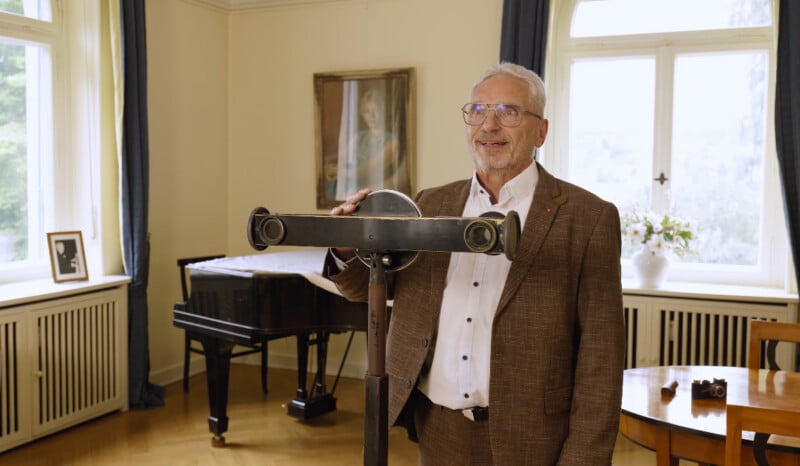How Leica Developed Its Legendary Rangefinder Cameras
For much of the last century, the rangefinder has defined Leica’s identity as a camera maker and shaped the way generations of photographers work. To mark its centennial, Leica revisits this groundbreaking invention and the story of how it forever changed photography.
A Century of Leica Innovation
This year, Leica celebrates its 100th anniversary, a milestone not just for the company but for photography as a whole. Few brands are as intertwined with the history of image-making as Leica, whose cameras have shaped photojournalism, documentary work, and creative expression for generations.

As part of the centennial celebration, Leica released a video titled Revolutionizing Photography: The Development of the Rangefinder, where Peter Karbe, Senior Managing Expert Optics and Platform at Leica Camera, unpacks the origins and enduring significance of the rangefinder system.
![]()
![]()
The Birth of the Rangefinder
In the early 20th century, Oskar Barnack, Leica’s pioneering engineer, recognized a fundamental problem: photographers struggled to accurately judge distance when focusing their cameras. At the time, most cameras relied on matte screens and estimation, a process too slow for capturing fleeting, candid moments. Barnack’s solution was the Fodis, an external accessory that used triangulation to measure distance.
“The rangefinder, in German ‘Entfernungsmesser,’ is an optomechanical tool with which you can measure the distance to the object you want to focus,” Karbe explains in the video.
By aligning two superimposed images into one, photographers could achieve precise focus. This invention became the backbone of Leica’s philosophy: to make photography faster, more spontaneous, and more accurate.
![]()
From Accessory to Integration: The Leica II
While the Fodis made focusing possible, it wasn’t exactly convenient. The breakthrough came in 1932 with the Leica II, the first camera to integrate the rangefinder directly into its body. With dual oculars, one for framing and one for focusing, the Leica II allowed photographers to quickly compose and focus without separate steps.
“In the advertisement you can read ‘Automatic Focusing.’ From today’s perspective, it’s not autofocus, but at that time it was revolutionary,” Karbe says.
The Leica II’s innovation didn’t just lie in speed. It also introduced interchangeable lenses via a screw mount. Each lens was engineered with gears that translated focusing movements into precise rangefinder adjustments, laying the groundwork for Leica’s future system cameras.
The M-System and the Leica M3
The next seismic leap came in 1954 with the Leica M3. Here, the dual-ocular system was streamlined into a single viewfinder that combined framing and focusing into one experience. The M3 also introduced the bayonet M mount, making lens changes faster and more secure. Frame lines for 50mm, 90mm, and 135mm lenses appeared within the viewfinder, providing photographers with a real-time preview of different focal lengths. Nearly a century after Barnack’s first experiments, the essential mechanical principle remains intact.
“The soul of Oskar Barnack is still buried in the M camera,” Karbe notes.
![]()
A Photographer’s Tool, Not Just a Camera
Rangefinders have always required a learning curve. Unlike modern mirrorless systems, where the final image is previewed instantly, Leica M users must visualize depth of field and composition in their mind before releasing the shutter.
“In principle it is always a challenge to use an M at the beginning,” says Karbe. “But once you have learned it, I think you will never want to do something different.”
He likens the experience to writing with a fountain pen. It may feel difficult and awkward at first, but once mastered, it becomes second nature and deeply rewarding. The rangefinder’s unique ability to show more than the final frame also gives photographers an edge in timing, allowing them to anticipate when subjects will enter or exit the composition.
![]()
Why the Rangefinder Still Matters
In today’s era of autofocus and live digital previews, the rangefinder may seem like an anachronism. Yet Leica’s enduring M-System proves its relevance. For many photographers, it remains the purest connection between eye, brain, and image, a tactile process that demands both technical skill and artistic vision.
As Leica marks 100 years, the rangefinder is more than a piece of photographic history. It is a living tool, still inspiring photographers to slow down, see differently, and capture the “Momentaufnahme,” the snapshot, that Oskar Barnack envisioned nearly a century ago.